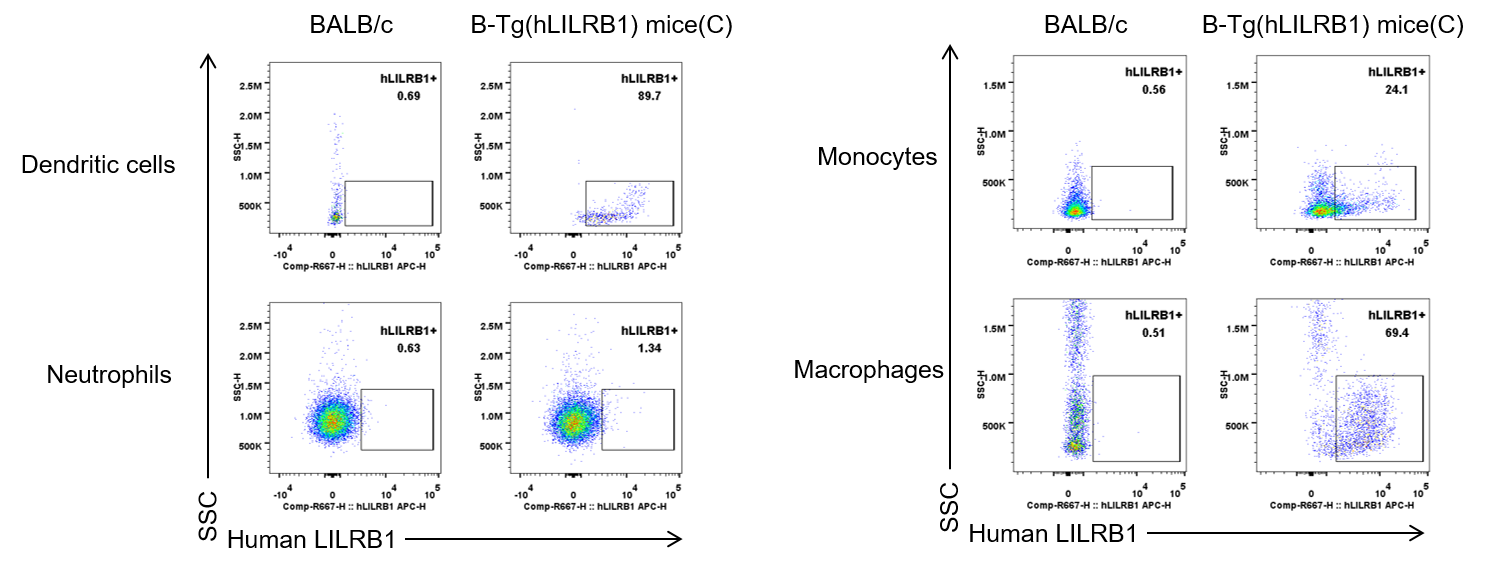
BALB/cCrSlcNifdc-Tg(CH17-49J22)1Bcgen/Bcgen • 112778
Gene targeting strategy for B-Tg(hLILRB1) mice(C) . The BAC clone CH17-49J22, which contains the full sequence of the human LILRB1 gene, was randomly inserted into B-Tg(hLILRB1) mice (C). Protein expression was driven by the human LILRB1 promoter.

Strain specific LILRB1 expression analysis in B-Tg(hLILRB1) mice(C) by flow cytometry. Splenocytes were collected from B-Tg(hLILRB1) mice(C), and analyzed by flow cytometry with species-specific anti-human LILRB1 antibody (eBioscience™, 17-5129-41). Human LILRB1 was detectable in B cells, T cells, and NK cells of B-Tg(hLILRB1) mice(C).

Strain specific LILRB1 expression analysis in B-Tg(hLILRB1) mice(C) by flow cytometry. Splenocytes were collected from B-Tg(hLILRB1) mice(C), and analyzed by flow cytometry with species-specific anti-human LILRB1 antibody (eBioscience™, 17-5129-41). Human LILRB1 was detectable in dendritic cells, monocytes, and macrophages of B-Tg(hLILRB1) mice(C), but not in neutrophils.

Strain specific LILRB1 expression analysis in B-Tg(hLILRB1) mice(C) by flow cytometry. Blood cells were collected from B-Tg(hLILRB1) mice(C), and analyzed by flow cytometry with species-specific anti-human LILRB1 antibody (eBioscience™, 17-5129-41). Human LILRB1 was detectable in B cells, T cells, and NK cells of B-Tg(hLILRB1) mice(C).

Strain specific LILRB1 expression analysis in B-Tg(hLILRB1) mice(C) by flow cytometry. Blood cells were collected from B-Tg(hLILRB1) mice(C), and analyzed by flow cytometry with species-specific anti-human LILRB1 antibody (eBioscience™, 17-5129-41). Human LILRB1 was detectable in dendritic cells, monocytes, and macrophages of B-Tg(hLILRB1) mice(C), but not in neutrophils.

Strain specific LILRB1 expression analysis in B-Tg(hLILRB1) mice(C) by flow cytometry. Splenocytes were collected from wild-type BALB/c mice (+/+) and B-Tg(hLILRB1) mice(C), and analyzed by flow cytometry with species-specific anti-human LILRB1 antibody. hLILRB1 was detectable in B cells, T cells and NK cells of B-Tg(hLILRB1) mice(C).

Strain specific LILRB1 expression analysis in B-Tg(hLILRB1) mice(C) by flow cytometry. Splenocytes were collected from wild-type BALB/c mice (+/+) and B-Tg(hLILRB1) mice(C), and analyzed by flow cytometry with species-specific anti-human LILRB1 antibody. hLILRB1 was detectable in monocytes, macrophages, and DCs of B-Tg(hLILRB1) mice(C), but not in neutrophils.

Strain specific LILRB1 expression analysis in B-Tg(hLILRB1) mice(C) by flow cytometry. Splenocytes were collected from wild-type BALB/c mice (+/+) and B-Tg(hLILRB1) mice(C), and analyzed by flow cytometry with species-specific anti-human LILRB1 antibody. hLILRB1 was detectable in B cells, T cells and NK cells of B-Tg(hLILRB1) mice(C).

Strain specific LILRB1 expression analysis in B-Tg(hLILRB1) mice(C) by flow cytometry. Splenocytes were collected from wild-type BALB/c mice (+/+) and B-Tg(hLILRB1) mice(C), and analyzed by flow cytometry with species-specific anti-human LILRB1 antibody. hLILRB1 was detectable in monocytes, macrophages, and DCs of B-Tg(hLILRB1) mice(C), but not in neutrophils.

Strain specific LILRB1 expression analysis in B-Tg(hLILRB1) mice(C) by flow cytometry. Blood cells were collected from wild-type BALB/c mice (+/+) and B-Tg(hLILRB1) mice(C), and analyzed by flow cytometry with species-specific anti-human LILRB1 antibody. hLILRB1 was detectable in B cells, T cells(low) and NK cells of B-Tg(hLILRB1) mice(C).

Strain specific LILRB1 expression analysis in B-Tg(hLILRB1) mice(C) by flow cytometry. Blood cells were collected from wild-type BALB/c mice (+/+) and B-Tg(hLILRB1) mice(C), and analyzed by flow cytometry with species-specific anti-human LILRB1 antibody. hLILRB1 was detectable in monocytes, macrophages, and DCs of B-Tg(hLILRB1) mice(C), but not in neutrophils.